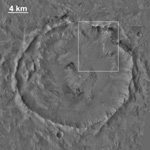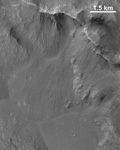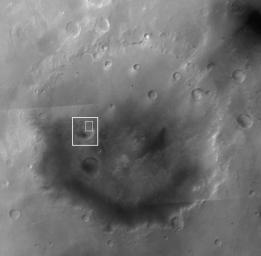 |  |
| Figure 1 | Figure 2 |
Thomas A. Mutch has been called an explorer of two worlds. Known to colleagues as Tim, he was born on August 26, 1931. An avid mountaineer as well as a scientist, he climbed in the Canadian Rockies and the Himalayas, and had a passion for exploration in all its forms. Mutch became a geologist after majoring in history at Princeton; he received a master's degree from Rutgers and a doctorate from Princeton. In 1960 he became a geology professor at Brown University, later serving as department chairman.
In the late 1960s, Mutch applied the geologic discipline called stratigraphy to the study of features on the Moon, work that led to his writing the landmark book, The Geology of the Moon. Mutch went on to become the leader of the Viking Lander Imaging Team, which had responsibility for obtaining and interpreting the first images from the surface of Mars. Following the successful touchdowns of Viking 1 on July 20, 1976 and Viking 2 a few weeks later, the twin landers transmitted a total of more than 4,000 images from the Martian surface.
Mutch had an ability to inspire those around him and a dedication to involving young people in the experience of exploration. He helped create the Viking Student Intern program, a pioneering educational activity since duplicated by many planetary missions, which allowed several dozen college students to participate in the Viking mission. At Brown, where he taught a seminar in exploration, he invited students to participate in a Himalayan climbing expedition. In May 1978, Mutch led a team of 32 students, faculty, and alumni to the21,900-foot Indian peak Devistan; 24 of them, including Mutch, made it to the summit.
In October 1980, Mutch died on the slopes of Mount Nun in the Himalayas, following a climbing accident while descending from the 23,410-foot summit. At the time he was on leave from Brown, serving as NASA's Associate Administrator for Space Science. His legacy endures in the many minds and spirits he helped nurture. In the planetary science community his former students include R. Stephen Saunders, James W. Head, III, Raymond E. Arvidson, and James B. Garvin. In 1981, NASA administrator Robert Frosch announced that the Viking 1 lander had been renamed the Mutch Memorial Station, and unveiled a stainless steel plaque that is to be placed on the lander, someday, by a team of explorers. The inscription on the plaque reads, "Dedicated to the memory of Tim Mutch, whose imagination, verve, and resolve contributed greatly to the exploration of the Solar System."
Located at 0.6°N, 55.3°W, Mutch Crater is about 211 kilometers (131 miles) in diameter. Naming of this crater for Tim Mutch was approved by the International Astronomical Union (IAU) in 1985.
The main image is a mosaic of Mars Global Surveyor (MGS) Mars Orbiter Camera (MOC) red wide angle images acquired during the MOC Geodesy Campaign in May 1999. The white boxes show the location of figures 1 and 2. Figure 1 is a mosaic of MOC and lower-resolution Mars Odyssey THEMIS VIS images that cover a smaller, unnamed crater located in west-central Mutch Crater. Figure 2 is a portion of the mosaic of the small, unnamed crater, showing landslide deposits formed when material slumped off the crater wall. The source alcoves of the landslides are well defined, as are longitudinal troughs and ridges on the surface of the landslides. These mass movements occurred long after the crater was formed, judging by the difference in the number of small impact craters on their surfaces and on the nearby floor of the crater.
The view of the landslides in the northeast corner of the small, unnamed crater in Mutch was acquired by the MGS MOC just a few days ago, on 23 August 2006, to commemorate the 75th birthday of Tim Mutch on 26 August 2006.
Noted space writer Andrew Chaikin (http://www.andrewchaikin.com), a former Tim Mutch student, suggested the 23 August 2006 MGS MOC image and contributed to the text of this release.

 Planetary Data System
Planetary Data System














